Speckle interferometry
|
Speckle interferometry utilise the correction of seeing noise by measuring the PSF imperfections. The image of unresolved object can be reconstructed by normalization of the short exposure Fourier images of target by a reference star. The resulting angular resolution can be higher than the diffraction limit of telescope as all exposed images are accounted for. Image series involving several thousand individual images required for speckle interferometry. The exposure time must be in order of 1-50 msec depending on the source brightness to freeze the atmospheric blur. An example of an individual image taken of source HD 185266 binary system (separation of ~0.57’, brightness of V=7.74.) with 20 msec exposure time shown in figure right. |
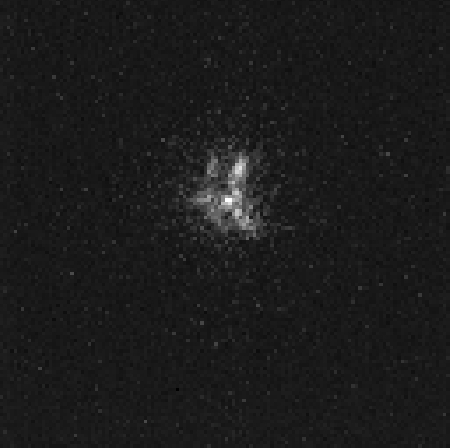 Individual frame of HD 185266. 
Individual frame of HD 185266. |
|
We successfully resolved the two components of the binary system HD 185266 by speckle interferometry. First, all images of a reference star (single star) are summed to get an average image. Secondly, the Fourier images of each individual image of the target system is taken. Thirdly, combination of the target and reference images at Fourier space revealing the separation, orientation, and brightness ratio, see figure on the right. Images were taken by ANDOR iXON 888 camera with 50cm Cassegrain telescope at Piszkestető Mountain Station of Konkoly Observatory.
|
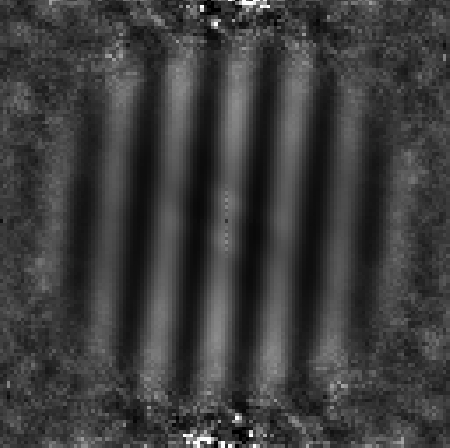 Speckle interferometry of HD 185266. 
Speckle interferometry of HD 185266. |
Lucky imaging
|
Lucky Imaging technique uses millisecond image capture rates to reduce the seeing effect caused by atmospheric turbulences. It combines multiple short exposure images (usually in R, I or Z band) into a single image, yielding a diffraction limited resolution. Selection of the best images is based on the image quality which is inferred by the total counts normalized by the number of pixel correspond to the target aperture. Lucky imaging of KOI-13 planet bearing binary system with separation of ~1”, and brightness of V=9.95, 10.2 can be seen on the figures below. The 10000 tip-tilt corrected images with seeing limited angular resolution (images in the upper row) can not resolve the system, however, combination of the best 3%-6% images results in diffraction limited angular resolution (images in the lower row). Images were taken by ANDOR iXON 888 camera with 50cm Cassegrain telescope at Piszkestető Mountain Station of Konkoly Observatory. |
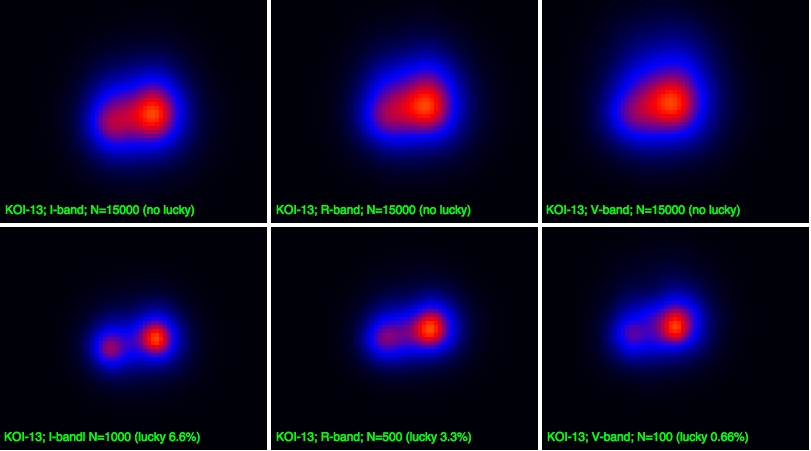
Power of lucky imaging in V, R, and I band. All images averaged (upper row) and only the best images (lower row). |
Related paper: Szabó, Gy. et al., 2011, ApJ, Volume 736, Issue 1, article id. L4;
ADS:2011ApJ...736L...4S;
arXiv:1105.2524
Precise differential photometry
|
Precise differential photometry utilise the 100% duty cycle capability accessible by the ANDOR iXON 888 camera’s frame transfer mode. Images taken with ~1sec exposure (in conventional mode, i.e. with no electron multiplication applied) are tip-tilt corrected and averaged. The flux measurement is based on adaptive aperture selection method in which only those pixels are selected in which the counts are above several sigma of the background noise. The resulting precision of the photometry enables us to catch exoplanet transits of 0.005 mag depth. An example of two transit of system P-32 (left) and WASP 33-B (right) measured in I-band are displayed in the figures below. Transit photometry were taken by ANDOR iXON 880 camera with 50cm Cassegrain telescope at Piszkestető Observatory. Both transit photometry apply only 3 reference star for the normalization. |
|
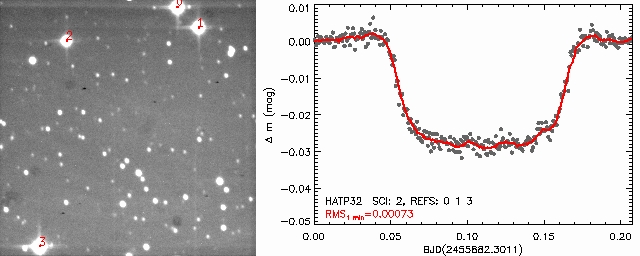
Transit photometry of HAT-P 32 measured in I-band. The target is labeled by ID 2 on the finding chart. |
|
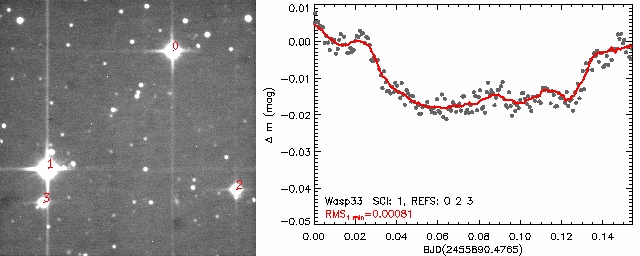
Transit photometry of Wasp 33 measured in I-band. The target is labeled by ID 1 on the finding chart. |
|
Related paper: Kovács, G. et al., 2013, A&A, Volume 553, id.A44;
ADS:2013A&A…553A..44K;
arXiv:1205.5060

